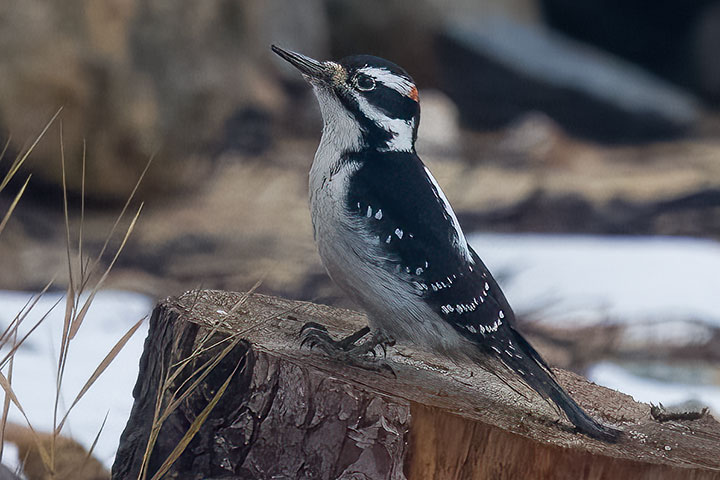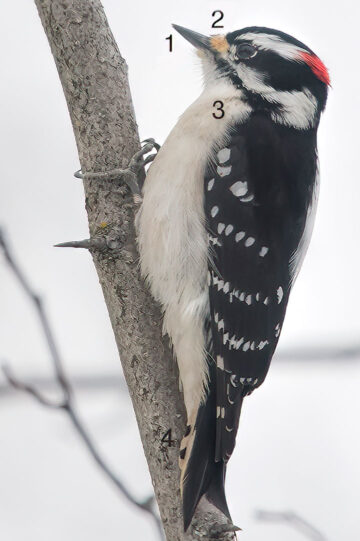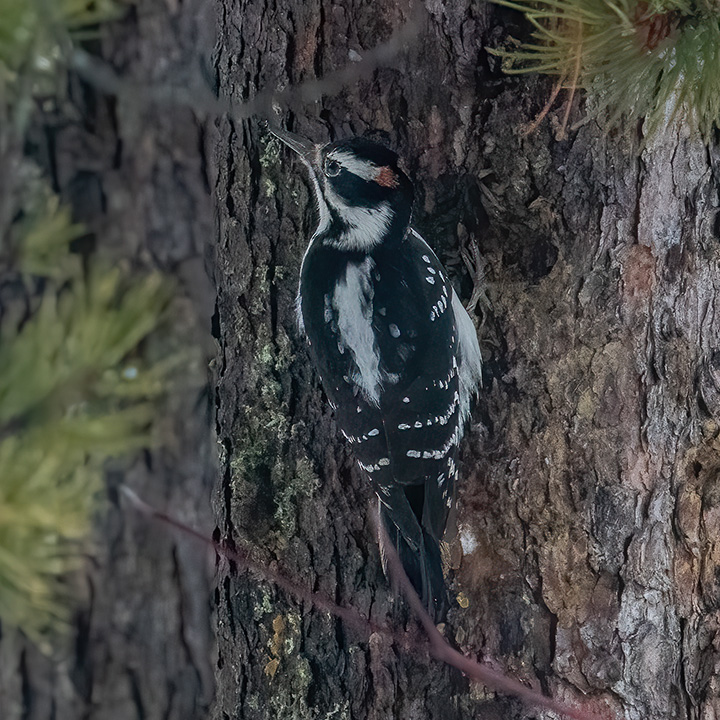I was watching a resident family of Northern Flickers flit between their favourite feeding areas, when to my absolute delight, another woodpecker flew over to join them.
In the West Kootenay, we have a half-dozen or more woodpeckers that either migrate through or live here permanently. Of those, the Hairy and Downy Woodpeckers are the most difficult to tell apart. (Their similarities probably arise by evolution since these two birds are not even in the same genus.) It is also relatively uncommon to see either bird around here, but the Hairy is more rare.
Six clues indicated my visitor was a Hairy Woodpecker.
Downy: mass 20 to 33 g; body length 14 to 18 cm.
Hairy: mass 40 to 95 g; body length 18 to 26 cm.
First was size. The Hairy is 2 to 3 times as heavy as the Downy, and about 30% to 40% longer.
The Hairy Woodpecker on the stump seemed closer in size to the nearby Northern Flickers and was significantly larger than the Song Sparrow foraging nearby in the grass.

After the woodpecker flew off, I measured the stump it pecked at for food. The bird was likely about 24 cm from beak tip to tail end; clearly a somewhat large Hairy.
To make further comparison easier, here is a photo (right) of a Downy Woodpecker taken previously by Alistair Fraser.  The places to look for differences between a Downy and Hairy are marked with four numbers.
The places to look for differences between a Downy and Hairy are marked with four numbers.
1. The Downy’s bill is much shorter. The Hairy’s bill is noticeably longer and similar to the length of its head.
2. Downy usually have fluffier tufts of feathers above their beaks.
3. The Hairy’s neck has a black downwards spur; the Downy has none.
4. The white-ish lower tail feathers are dotted black only on the Downy.
This Downy also has a brighter red head patch than my visiting woodpecker, but that colour difference may be due to my father’s Downy being an older more mature male.
When my visiting woodpecker flew to a nearby low-lit tree, it had the namesake hair-like or thread-like white back feathers. It also showed white unmarked tail feathers and a reddish-ginger head patch that was split in two. Apparently a male Hairy’s red patch often splits in two, while the Downy’s does not.

Finally, despite this somewhat ginger-coloured head patch, I am confident my visitor was a Hairy (and not a disguised royal Harry off the grid in Canada!) What do you think?

Great photo of a Hairy Woodpecker. Nice summary of the differences.
I really enjoyed your summary of the differences of the gorgeous photos !
I’ve always been able to recognize the bill difference, once you’ve seen several of each bird it becomes apparent. But thank you for the other confirming marks, really helpful! Best advice I read somewhere about Hairy vs. Downy is: “If you’re not sure which it is, it’s a Downy” 🙂
When I lived in Northern California both were locally common and I always struggled, and mostly gave up, trying to sort them out. But this was an excellent summary of the differences. Thank you!
in ontario i learned pretty early on that i could identify them by the bill. even at quite a distance.
Now…if I just remember all these distinguishing characteristics…very fine points…thanks! I simply try to discern if I’m seeing a smaller, or larger so similar woodpecker, when they’re not together…and remember that “down” is shorter than hair, usually…so I can remember what to call each!
I liked your analysis of the two look-like woodpeckers. As a rule I have used the length-of-beak comparison where the beak of the Downy is less than half the length of the head, and that of the Hairyis greater than half the length of its head. Sometimes other distinguishing marks are not clearly visible because of poor lighting or poor angle of vision.
Ed McMackin
Kootenay Lake-Creston Wildflowers.
PS. Have you, Cynthia, taken over the helm for your Dad?
Yes, for many of us the beak seems the easiest identifier. Regarding the blog: my father does a vast majority of the postings; I do an occasional guest posting. It is a joy to explore together.
Great post. Just one flaw though, they are in the same genus – Dryobates.
Scott, thank you. Your comment caused me to dig deeper into the nomenclature of the hairy. In the past, the hairy was usually placed in either genus Dendrocopos or Picoides. As a result of a detailed study, in 2015 the Hairy Woodpecker was moved to the genus Leuconotopicus. So the downy and hairy are not presently seen as being in the same genus. Yet, some taxonomic authorities do place the Hairy Woodpecker in an expanded Dryobates, so the issue remains unsettled. See Wikipedia, for example.
I just discovered this site, great local information, thank you!
Beautiful. Thank you for sharing with us : )